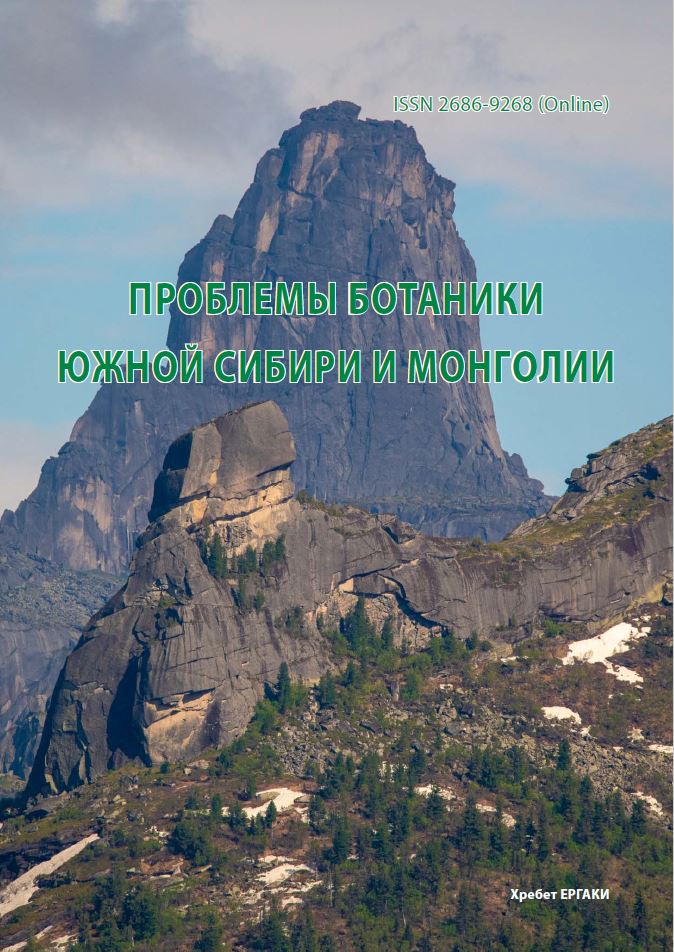Seasonal photosynthesis and respiration dynamics of Pinus sibirica latitudinal ecotypes: ex situ study
УДК 582.475.4:581.121+581.132
Abstract
Photosynthesis and respiration are temperature dependent processes. Therefore, it is important to understand how the physiological processes of photosynthesis and respiration will respond to climate change in the future. Seasonal carbon dioxide gas exchange of vegetative scion Siberian stone pine ecotypes (Pinus sibirica Du Tour) of latitudinal transect grown in the scientific station “Kedr” in the south of the Tomsk region were studied. The latitudinal transect was represented by two ecotypes: the southern ecotype (Tomsk) and the northern ecotype (Urengoy). The age of the grafted trees was 26 years. Apparent uptake of CO2 of the southern ecotype began a week earlier than the one of the southern ecotype, when the needle length reached 35 and 40 % of the final length of the southern and southern ecotypes, respectively. Photosynthesis reaches its maximum values when the needle length was 45-52 % of the final length of both ecotypes. The carbon dioxide assimilation rate of the southern ecotype remained high until the second decade of July, then its intensity decreased. Photosynthetic rate of the southern ecotype decreased in early August. In fully developed needles, the photosynthetic intensity between ecotypes did not differ significantly. The dark respiration of both ecotypes was maximum at the beginning of needle growth, then decreased significantly, was almost constant in July, and had minimum values at the end of the growing season. At the initial growth stages the needles of the southern ecotype had high values of dark respiration, which was 2 times higher than that of the southern ecotype. In the growth process by the first ten days of
July, the differences between ecotypes were practically leveled. Subsequently, the dark respiration of the southern ecotype became 2 times higher than that of the southern one, however, it remained low compared to the initial stages of needle growth. The respiration of needle finished growing decreased by 8-10 times. The negative balance between photosynthesis and respiration of both ecotypes maintained until the needle length exceed 40 % and 35 % of the final length in the northern and southern ecotypes, respectively. Positive balance CO2 was observed when the needle length reached 45 % in the northern and 52 % in the southern ecotypes. During the summer months the CO2 balance was significantly higher for the Tomsk ecotype. In September and October the CO2 balance of the northern ecotype became lower than of one the southern one due to increased part of respiration of gas exchange. We believe that the high respiratory intensity of the Siberian stone pine northern ecotype is hereditary, therefore significant respiratory costs will have negative impact the productivity of high latitude plants and their adaptation to climate warming.
Downloads
Metrics
References
Алексеев В. А. Диагностика жизненного состояния деревьев и древостоев // Лесоведение, 1989. - № 4. - С. 51-57. Головко Т. К. Дыхание растений (физиологические аспекты). - СПб.: Наука, 1999. - 204 с.
Ковалев А. Г., Антипова О. В. Влияние интенсивности света на анатомо-морфологическое строение хвои сосны // Лесоведение, 1983. - № 1. - С. 29-34.
Медведев С. С. Физиология растений: учебник. - СПб.: БХВ-Петербург, 2012. - 512 с.
Цельникер Ю. Л., Малкина И. С., Ковалев, А. Г., Чмора С. Н., Мамаев В. В., Молчанов А. Г. Рост и газообмен СО2 у лесных деревьев. - М.: Наука, 1993. - 256 с.
Crous K. Plant responses to climate warming: physiological adjustments and implications for plant functioning in a future, warmer world // Am. J. Bot, 2019. - Vol. 106, № 8. - P. 1-3. DOI: 10.1002/ajb2.1329
Fierravanti A., Rossi S., Kneeshaw D., Grandpre L. D., Deslauriers A. Low non-structural carbon accumulation in spring reduces growth and increases mortality in conifers defoliated by spruce budworm // Front. For. Glob. Change, 2019. - Vol. 1. - P. 1-13. DOI: 10.3389/ffgc.2019.00015
Hikosaka K., Ishikawa K., Borjigidai A., Muller O., Onoda Y. Temperature acclimation of photosynthesis: mechanisms involved in the changes in temperature dependence of photosynthetic rate // Journal of Experimental Botany, 2006. -Vol. 57, №. 2. - P. 291-302. DOI: 10.1093/jxb/erj049
Kagawa A., Sugimoto A., Maximov T. C. Seasonal course of translocation, storage and remobilization of 13C pulse-labeled photoassimilate in naturally growing Larix gmelinii saplings // New Phytol., 2010. - Vol. 171, - P. 793-804. DOI: 10.1111/j.1469-8137.2006.01780.x
Klein T., Vitasse Y., Hoch G. Coordination between growth, phenology and carbon storage in three coexisting deciduous tree species in a temperate forest // Tree Physiol., 2016. - Vol. 36. - P. 847-855. DOI: 10.1093/treephys/tpw030
Zu K., Wang Z., Zhu X., Lenoir J., Shrestha N., Lyu T., Luo A., Li Y., Ji C., Peng S., Meng J., Zhou J. Upward shift and elevational range contractions of subtropical mountain plants in response to climate change // Science of the Total Environment, 2021. - Vol. 783, № 7. - P. 1-10. DOI: 10.1016/j.scitotenv.2021.146896



